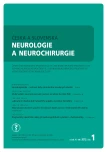Visual Functions in Premature Children with Perinatal Brain Injury
Authors:
D. Liláková 1; D. Hejcmanová 1; J. Jakubec 2; E. Rencová 1
Authors‘ workplace:
LF UK a FN Hradec Králové
Oční klinika
1; LF UK a FN Hradec Králové
Neurochirurgická klinika
2
Published in:
Cesk Slov Neurol N 2012; 75/108(1): 58-61
Category:
Short Communication
Overview
The aim of this work is to evaluate the visual functions in premature children who have suffered perinatal brain injury. The study includes children with intraventricular haemorrhage, periventricular leukomalatia, brain atrophy and post-haemorrhagic hydrocephalus, all of which have required surgery. In the course of ophthalmological examination, we checked visual acuity, refractive errors and strabismus. Only 35.4% of the children in the study group had normal visual acuity. Refractive errors were revealed in 55.8% of patients, with hypermetrophy prevailing (85.7% of all children with refractive errors). We found strabismus in 47.9% of the children. It is clear from these results that regular ophthalmology checkups are essential for premature children with brain injury, as is early compensation of their ocular insufficiency.
Key words:
premature children – post-haemorrhagic hydrocephalus – visual functions
Sources
1. Jacobson L, Dutton G. Periventricular leukomalacia: an important cause of visual and ocular motility dysfunction in children. Surv Ophthalmol 2000; 45(1): 1–13.
2. Pike MG, Holmström G, de Vries LS, Pennock JM, Drew KJ, Sonksen PM et al. Patterns of visual impairment associated with lesions of the preterm infant brain. Dev Med Child Neurol 1994; 36: 849–862.
3. Phillips J, Christiansen P, Ware G, Landers S, Kirby RS. Ocular morbidity in very low birth-weight infants with intraventricular hemorrhage. Am J Ophthalmol 1997; 123(2): 218–223.
4. Cinalli G, Maixner WJ, Sainte-Rose C. Pediatric Hydrocephalus. 1st ed. Milan: Springer Verlag 2004.
5. Jacobson L, Ygge J, Flodmark O, Ek U. Visual and perceptual characteristics, ocular motility and strabismus in children with periventricular leukomalacia. Strabismus 2002; 10(2): 179–183.
6. Spierer A, Royzman Z, Kuint J. Visual acuity in premature infants. Ophthalmologica 2004; 218(6): 397–401.
7. Saunders KJ, McCulloch DL, Shepherd AJ, Wilkinson AG. Emmetropisation following preterm birth. Br J Ophthalmol 2002; 86(9): 1035–1040.
8. Dutton G. Congenital disorders of the optic nerve: excavations and hypoplasia. Eye 2004; 18(11): 1038–1048.
9. Denne C, Käsmann-Kellner B, Ruprecht KW. Prevalence of optic atrophy and associated ocular and systemic diseases in a department of paediatric ophthalmology. Klin Monatsbl Augenheilkd 2003; 220(11): 767–773.
10. Huo R, Burden S, Hoyt C. Chronic visual impairment in children: etiology, prognosis, and associated neurological defects. Br J Ophthalmol 1999; 83(6): 670–675.
Labels
Paediatric neurology Neurosurgery NeurologyArticle was published in
Czech and Slovak Neurology and Neurosurgery

2012 Issue 1
- Metamizole vs. Tramadol in Postoperative Analgesia
- Memantine in Dementia Therapy – Current Findings and Possible Future Applications
- Memantine Eases Daily Life for Patients and Caregivers
- Metamizole at a Glance and in Practice – Effective Non-Opioid Analgesic for All Ages
- Advances in the Treatment of Myasthenia Gravis on the Horizon
Most read in this issue
- Vertebroplasty – Treatment Option for Structurally Insufficient Vertebras
- Carpal Tunel Syndrome and Neurosurgeon – Experience after 2,200 Surgeries
- Guillain-Barré Syndrome in a Patient with a Renal Carcinoma – a Case Report
- Guidelines for Pharmacotherapy of Neuropathic Pain
